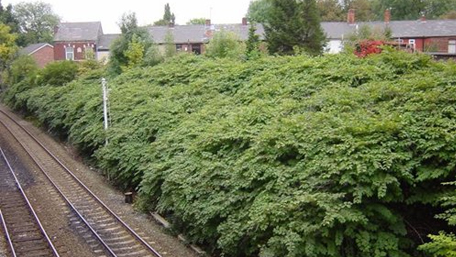Japanese Knotweed
Land Remediation Tax Relief is available for Japanese Knotweed

Removing Japanese Knotweed, so as to prepare land ready for re-development, can be very expensive. It often costs substantially more than anticipated. In recognition of this, Land Remediation Tax Relief is available to property developers and investors involved in redeveloping brownfield sites. Whether sites are suffering from contamination or long term dereliction, including Japanese Knotweed infestations, the relief aims to encourage such sites being brought back into economic use.
E3 Consulting are specialists in maximising tax savings through Land Remediation Tax Relief (LRTR). We regularly undertake claims involving a wide variety of contaminants on land, including Japanese Knotweed and amongst others; arsenic, radon, hydrocarbons and heavy metals.
What is Japanese Knotweed?
Japanese Knotweed is a bamboo like plant considered to be the most invasive non-native plant in the UK. Alan Titchmarsh called it the “most notorious plant in Britain”. Japanese Knotweed grows prolifically (several inches in a day in peak growing season) and as such can be difficult and costly to eradicate. It has the potential to cause great damage to buildings and structures because of its highly aggressive nature - often penetrating bricks, tarmac and concrete.
In 2003 DEFRA estimated that the cost of eradicating Japanese knotweed throughout the UK would cost £1.5 billion and the figure is now likely to be higher. Japanese Knotweed was first introduced into Britain in the Victorian age as an ornamental plant. The plant is notable for growing a prolific network of roots and rhizomes encouraging its use on railway cuttings and canal embankments to help stabilise the earthworks.
What is Land Remediation Tax Relief?
Land Remediation Tax relief provides up to 150% tax relief on qualifying expenditure incurred in the cleaning up of contaminated land. Available since May 2001, it was publicised widely that LRTR was to be scrapped in March 2011 following a review by the Office of Tax Simplification. However, in recognition of the negative impact its withdrawal could have had on the housing industry, LRTR was then subsequently reprieved in the Budget 2012. This fact was much less publicised, meanin some people are often wrongly under the impression that it no longer exists.
LRTR for Japanese Knotweed
From April 2009 HMRC accepted that land remediation tax relief was eligible for the removal of infestations of Japanese Knotweed; in cases where it has not been planted or spread to a site through the activities of the claimant or a connected party. The extension of LRTR aimed to address market failures due to long term derelict land, often involving land sites infested by Japanese Knotweed, in the hopes of encouraging the development of such land.
Considering that LRTR has been around since 2001, many companies are still not aware that it exists and this is equally true of their accountants, lawyers & surveyors. This is even truer for issues such as Japanese Knotweed which had not been included in the relief until relatively recently. HMRC guidance recognises that Japanese Knotweed is such an invasive and destructive plant that is satisfies the ‘harm’ test.
Ordinarily, HMRC hold that LRTR is only available on land in a contaminated state at the time of acquisition. However, in the case of Japanese Knotweed it is recognised that since infestation can occur during ownership, through no fault of the landlord, the requirement that land must be acquired in a contaminated state does not apply. This is because often Japanese knotweed is introduced through means like fly tipping.
Historically, many contractors have preferred to ‘dig and dump’ their Japanese knotweed waste in landfill. Whilst this would mean that they could not claim LRTR it has often been considered that this was as a quicker and cheaper method that proper eradication. Since the extra time needed for treatment methods of eradication have proved expensive through the accumulating interest from delaying the project awaiting the growing season. After all ‘time is money’. However with the substantial rise in landfill tax rates, (currently £72 per tonne), together with the removal of landfill tax exemption for contaminated waste, this is no longer the case, making claiming LRTR a much more necessary option to factor into the onsite remediation strategies.
Seeking Specialist Tax advice
Land Remediation Tax Relief claims for issues such as Japanese Knotweed are a complex area; as such they require an expert approach to ensure that the necessary criteria are met on the expenditure incurred. For instance, LRTR is not applied when Japanese Knotweed is taken to landfill. Instead the Japanese Knotweed must be treaded in situ or at an offsite treatment centre in order to qualify for the relief. LRTR, in addition to Japanese Knotweed, is claimable on a wide range of other contaminants (including radon, arsenic, a wide range of hydrocarbons) and the specifics for these are often incredibly intricate meaning it is paramount to seek specialist tax advice in order to maximise your potential tax savings. Notably the tax position is completely separate from the environmental or liability issues that environmental lawyers or engineers tend to focus upon.
Loss Relief from HMRC
If your company is currently forecasting a short term loss on account of the project investment, these losses generated by Qualify Land Remediation expenditure can be surrendered for 16% of the loss - thus HMRC will issue a cheque in respect to the surrendered losses - significantly boosting early project cash flows.
We have undertaken LRTR claims for a range of clients (large and small) and project situations throughout the UK. We would be delighted to hear from you as to how we can help your specific projects.




